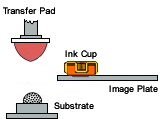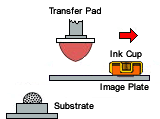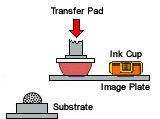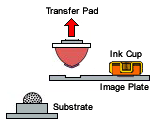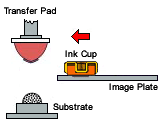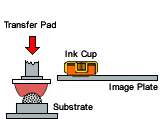Pad printing is an indirect offset (gravure) printing process that involves an image being transferred from the printing plate (cliché) via a silicone pad onto a substrate (surface to be printed). There are two common methods used in inking the plates: the open inkwell system, old inking method, and the sealed ink cup (also known as closed cup) modern system.
Open ink well systems (older technology) use a trough (ink well) for the ink supply, located behind the printing plate. A flood bar pushes a pool of ink over the plate, and a doctor blade removes the ink from the plate surface, leaving ink on the etched artwork area ready for the pad to pick up.
Sealed ink cup systems (latest technology) employ a sealed container (ink cup), which acts as the ink supply, flood bar and doctor blade all in one. A ceramic ring with a highly polished working edge provides the seal against the printing plate.
From the home position, the sealed ink cup sits over the etched artwork area of the printing plate, covering the image and filling it with ink.
The sealed ink cup moves away from the etched artwork area, taking all excess ink and exposing the etched image, which is filled with ink. The top layer of ink becomes tacky as soon as it is exposed to the air, which is how the ink adheres to the transfer pad and later to the substrate.
The transfer pad presses down onto the printing plate momentarily. As the pad is compressed, it pushes air outward and causes the ink to lift (transfer) from the etched artwork area onto the pad.
As the transfer pad lifts away, the tacky ink film inside the etched artwork area is picked up on the pad. A small amount of ink remains in the printing plate.
As the transfer pad moves forward, the ink cup also moves to cover the etched artwork area on the printing plate. The ink cup again fills the etched artwork image on the plate with fresh ink in preparation for the next cycle.
The transfer pad compresses down onto the substrate, transferring the ink layer picked up from the printing plate to the substrate surface. Then, it lifts off the substrate, returning to the home position, which completes one print cycle.
The preceding description of a typical pad printing cycle also introduces these key elements of pad printing:
- The Printing Pad
Pads are three dimensional objects typically molded of silicone rubber. They function as a transfer vehicle, picking up ink from the printing plate, and transferring it to the part (substrate). They vary in shape, size and durometer depending on the application.There are three main shape groups: “round pads”, long narrow pads called “bar pads” and miscellaneous shapes (square, rectangular, etc.) called “loaf pads”. Within each group there are three size categories: small, medium and large size pads. It is also possible to engineer custom-shaped pads to meet special application requirements.
- The Image Plate
Image plates are used to contain the desired artwork “image” etched in its surface. Their function is to hold ink in this etched cavity, allowing the pad to pick up this ink as a film in the shape of the artwork, which is then transferred to the substrate.There are two main types of printing plate materials: photopolymer and steel. Photopolymer plates are the most popular, providing a good do-it-yourself option.
These are typically used in short to medium production runs. Steel plates are made of thin steel typically .5mm thick.
Steel plates are generally processed by the plate supplier as it involves the use of specialized equipment. - The Ink
Ink is used to mark or decorate parts. It come in different chemical families to match the type of material to be printed (please consult the substrate compatibility chart for selection).Pad printing inks are “solvent-based” and require mixing with additives at the time of use. They typically dry to the touch in seconds although complete drying (cure) might take a substantially longer period of time. Please consult with our ink technical sheets for batch makeup information and watch our Ink Mixing instructional video.
Climatic conditions will significantly affect the performance of any pad printing ink, please bear this in mind when planning the location of your pad printer. Always consult Federal, State and local regulations regarding proper handling, storage and disposal of inks.
- The Substrate
Substrate is the technical name used to address any parts or materials to be printed. As explained in the “Inks” section above, it is critical to match substrates and ink series as to their chemical compatibility. Please consult the substrate compatibility chart for proper ink selection. Typically you will need a “jig” or “fixture” to hold and support your substrate in order to ensure good quality printing. Note that substrates need to be clean and free from surface contamination to allow proper ink adhesion.
This introduction to pad printing serves to provide the press operator with a basic working knowledge of pad printing, the pad printing process and the key elements of pad printing. More in-depth knowledge can be obtained by consulting with your operator’s manual, watching our training videos, reading through the additional information contained in these pages and through the process of gaining experience. If you have questions, be sure to read our Frequently Asked Questions and Troubleshooting Guides. If you are still not achieving the desired results, we can help. Write us an email using the form on this page, or contact our toll-free technical support at (800) 982-1928. We’re available Monday through Friday from 8 a.m. Eastern Standard Time to 4 p.m. Pacific Standard Time.

